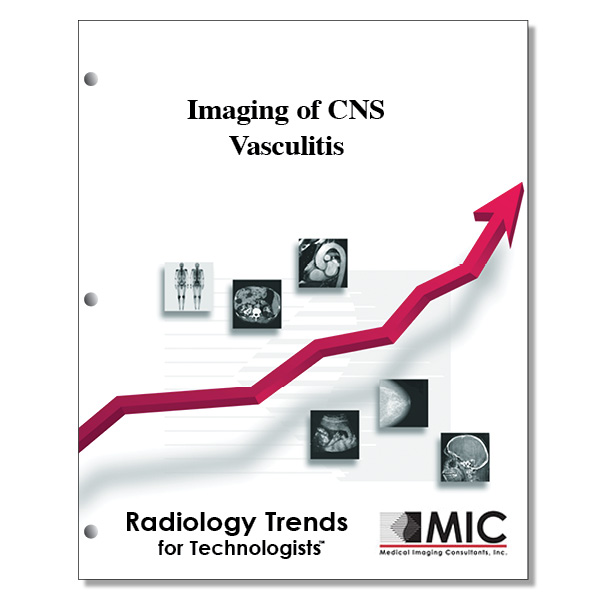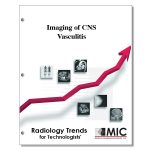

Imaging of CNS Vasculitis
Various types of CNS vasculitis are discussed, including classification, imaging methods, and image appearance.
Course ID: Q00426 Category: Radiology Trends for Technologists Modalities: CT, MRI, Sonography, Vascular Interventional3.0 |
Satisfaction Guarantee |
$34.00
- Targeted CE
- Outline
- Objectives
Targeted CE per ARRT’s Discipline, Category, and Subcategory classification for enrollments starting after May 25, 2023:
[Note: Discipline-specific Targeted CE credits may be less than the total Category A credits approved for this course.]
Computed Tomography: 3.00
Procedures: 3.00
Head, Spine, and Musculoskeletal: 3.00
Magnetic Resonance Imaging: 3.00
Procedures: 3.00
Neurological: 3.00
Nuclear Medicine Technology: 1.00
Procedures: 1.00
Other Imaging Procedures: 1.00
Registered Radiologist Assistant: 3.00
Procedures: 3.00
Neurological, Vascular, and Lymphatic Sections: 3.00
Vascular-Interventional Radiography: 3.00
Procedures: 3.00
Vascular Diagnostic Procedures: 3.00
Vascular Sonography: 0.50
Procedures: 0.50
Extracranial Cerebral Vasculature and Other Sonographic Procedures: 0.50
Outline
- Introduction
- Classification
- Methods of Examination
- Magnetic Resonance Imaging
- Computed Tomography
- Positron Emission Tomography/CT
- Color Duplex US
- Digital Subtraction Angiography
- Biopsy
- Interpretation
- Parenchymal Changes
- Vascular Changes
- Associated Findings
- Large-Vessel Vasculitis
- Takayasu Arteritis
- Giant Cell Arteritis
- Vasculitis of Medium-sized Vessels
- Polyarteritis Nodosa
- Kawasaki Disease
- Small-Vessel Vasculitis
- IgA Vasculitis
- Microscopic Polyangiitis
- Granulomatosis with Ployangiitis
- Eosinophilic Granulomatosis with Polyangiitis
- Vasculitis of Variable-sized Vessels
- Bechet Disease
- Cogan Syndrome
- Single-Organ Vasculitis
- Primary Angiitis of the CNS
- Reversible Cerebral Vasoconstriction Syndromes
- Moyamoya Disease
- Vasculitis associated with Systemic Disease
- Systemic Lupus Erythematosus
- Sjˆgren Syndrome
- Rheumatoid Arthritis
- APLA Syndrome
- Scleroderma
- Vasculitis Associated with Probable Cause
- Acute Septic Meningitis
- Tuberculous Vasculitis
- Neurosyphilis Vasculitis
- Varicella-Zoster Virus Vasculitis
- HIV-related Vascultisi
- Fungal Vasculitis
- Cysticercosis
- Malignancy-induced Vasculitis
- Drug-induced Vasculitis
- Radiation-induced Vasculitis
- Conclusion
Objectives
Upon completion of this course, students will:
- define cerebral vasculitis
- learn the manifestations of cerebral vasculitis
- identify the associations of CNS vasculitis
- identify the indications of cerebral vasculitis
- establish criteria for defining vasculitis
- define sensitivity and specificity
- distinguish sensitivity from specificity
- identify the most common imaging modality in diagnosing vasculitis
- identify the importance of FLAIR imaging in MRI
- establish the value of SWI in diagnosing microhemorrhages
- identify the optimal imaging technique in the evaluation of Takayasu arteritis
- identify which pathology CT is best suited for, relative to MRI
- identify the value of perfusion CT in the setting of vasculitis
- identify the optimal imaging method for visualizing the “halo sign” in patients with acute temporal arteritis
- show the importance of DSA in small artery evaluation, compared to MRA and CTA
- identify optimal sequences in evaluation of hemorrhage, hematoma or microbleeds
- become familiar with the identifying characteristics of Takayasu arteritis
- become familiar with the identifying characteristics of giant cell arteritis
- identify the attributes of polyarteritis nodosa
- identify the characteristics of Kawasaki disease
- distinguish the characteristic findings of Wegener granulomatosis
- define and identify the traits of Behcet disease
- become familiar with the identifying characteristics of RCVS
- identify the characteristics of moyamoya disease
- establish criteria for identification of SLE
- distinguish the advantages of MR sequences when evaluating for microbleeds in APLA syndrome
- identify the characteristics of scleroderma
- identify the most common cause of chronic meningitis
- identify the characteristics of neurosyphilis vasculitis
- define VZV and establish the manifestations of the disease
- identify the characteristics of IgA vasculitis
- identify the fusiform characteristic of HIV-related aneurysms
- identify the characteristics and imaging value of cysticercosis
- describe and establish characteristics of drug-induced vasculitis
- describe and define radiation-induced vasculitis
